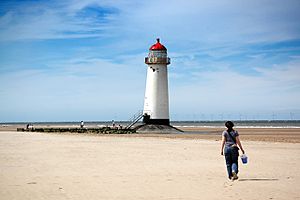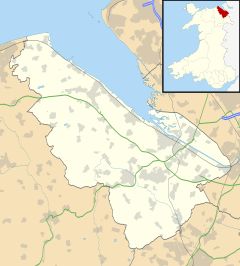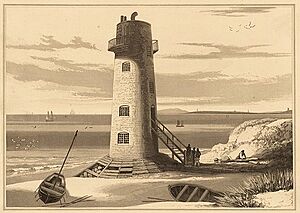Point of Ayr facts for kids
Quick facts for kids Talacre |
|
|---|---|
 The beach at Talacre |
|
| OS grid reference | SJ1202 8530 |
| Principal area | |
| Country | Wales |
| Sovereign state | United Kingdom |
| Post town | HOLYWELL |
| Postcode district | CH8 |
| Dialling code | 01745 |
| Police | North Wales |
| Fire | North Wales |
| Ambulance | Welsh |
| EU Parliament | Wales |
| UK Parliament |
|
| Welsh Assembly |
|
Point of Ayr (which is Y Parlwr Du in Welsh) is the most northern point of mainland Wales. It is located right next to Talacre in Flintshire. This special spot is at the mouth of the Dee estuary, which is where the river meets the sea. It's also southwest of the Liverpool Bay area in the Irish Sea.
Point of Ayr is home to an RSPB (Royal Society for the Protection of Birds) nature reserve. This means it's a protected area for birds and wildlife. It's also part of the Gronant and Talacre Dunes Site of Special Scientific Interest. This protects its important sand dunes.
Contents
What Was Coal Mining Like Here?
For many years, a coal mine operated at Point of Ayr. This mine was at the very northern end of the Flintshire Coalfield. It was one of the last deep mines still working in Wales.
How Did Coal Mining Start?
The first tests to find coal happened in 1865. Lord Mostyn, who owned another mine nearby, led these tests. They seemed to work well, and a company called the Prestatyn Coal Company was formed. However, the project was stopped before it really began.
In 1873, another company, the Western Mostyn Colliery Company, looked at the site again. Their test shaft wasn't successful, and the project was stopped once more.
When Did the Mine Open?
In 1883, a third company, the Point of Ayr Colliery Company, was created. Finally, in 1890, they found a coal seam! Back then, 75 pit ponies helped bring the coal to the surface. A second shaft was also dug around this time.
By 1896, the mine employed 356 men. They produced coal for homes and factories. After the National Coal Board took over in 1947, a third shaft was dug. The coal field stretched northwards, even under the Irish Sea. Sadly, six men lost their lives during the digging of a new shaft on July 4, 1952. By 1953, 738 men were working there, producing 213,000 tons of coal each year.
When Did the Mine Close?
The Point of Ayr colliery closed on August 23, 1996. Today, nothing remains of the mine itself. However, a brass band called the "Point of Ayr Colliery Band" keeps its name alive.
What About Oil from Coal?
In the early 1980s, this site was chosen for a special project. It was meant to be a demonstration plant to turn coal into oil. The government and the National Coal Board helped pay for it. Small-scale tests were done, but the project was cancelled. This happened because of a miners' strike and cuts to research funding. So, the plant never actually started working and was taken apart.
How is Natural Gas Used Here?
Point of Ayr is also where natural gas from the Celtic gas fields comes to shore. Gas travels through a pipeline that is 33.5 kilometers (about 20 miles) long. This pipeline connects to the Douglas Complex, which is a group of gas and petroleum drilling platforms in the Irish Sea.
How is the Gas Processed?
The Point of Ayr gas terminal can process a huge amount of gas every day. It removes things like methanol, water, and a liquid called condensate. The gas is also "sweetened" to remove sulfur compounds, making it cleaner. Then, it's chilled to make sure it stays in a gas form.
This processing plant was first part of a project by BHP Billiton. Now, it is owned and run by Eni. The processed gas then travels through another underground pipeline. This pipeline is 27 kilometers (17 miles) long and goes to Connah's Quay. After more processing, the gas is sold to Uniper. They use it for their power station at Connah's Quay, which is on Deeside in Flintshire.
What About the Lighthouse?
Point of Ayr also has a famous lighthouse. It was built in 1776 but stopped working in 1883. You can find it on Talacre beach, right at the entrance to the River Dee estuary.
How Did the Lighthouse Work?
The lighthouse used to have two lights. The main light was 63 feet high and shone out to sea towards Llandudno. A second light shone up the River Dee, towards a small village called Dawpool in Cheshire, on the English side of the estuary.
When it was working, the lighthouse was painted with red and white stripes. It also had a red lantern at the top. In 1844, a new metal lighthouse replaced it. This new one had a white light and was put up by the Corporation of Trinity House. However, this new lighthouse was itself replaced in 1883 by a lightship, which is like a floating lighthouse.



